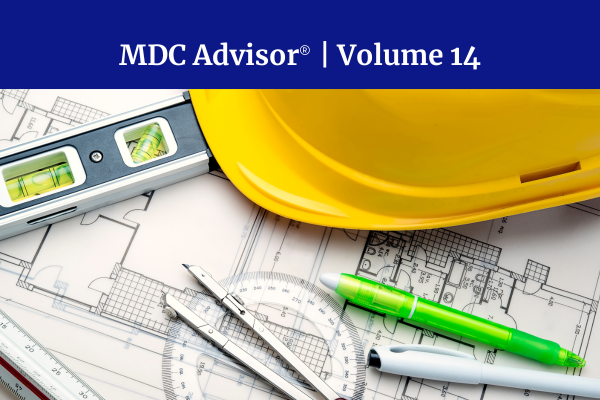
Project Risk Reduction
In this edition:
- Project Risk Reduction, article by Daniel J. Sporer, Consultant for MDC Systems®
- Risk Management in Design, article by E. Mitchell Swann, P.E., Partner of MDCSystems®
- Can Clean be Green? How can Cleanroom-based industries climb aboard the ‘green train’? presentation by E. Mitchell Swann, P.E.
- A Global Owner,Joe Gionfriddo,Corporate Engineering at Proctor & Gamble talks about Project Execution, an interview with Mitchell Swann of MDCSystems®
Project Risk Reduction
By Daniel J. Sporer
Consultant for MDCSystems®
Some project histories are very complex and traditional schedule and damage analysis methods are not able to quantify the impacts of events that have occurred over the life of the project. In these situations MDC has relied upon more sophisticated mathematical and system based models to attribute impacts to particular events. The usual methods of determining and reducing risk on construction projects include schedule forecast, cost forecasts and change review analysis performed by the project team.
However, sometimes these techniques do not allow for an overview that properly adds the effects of many individual events. On these occasions, the project team needs more powerful and sophisticated tools that include multiple project factors, such as resource availability, site conditions, environmental factors, and productivity levels for both planned and actual conditions. This wide range of factors cannot typically be completely comprehended by the project manager without the aid of analysis.
MDC System’s Recent Presentations
ASHRAE Annual Meeting
E. Mitchell Swann, P.E. presented “Can Clean be Green? – How can Cleanroom-based industries climb aboard the ‘green train’?”
London Superconference
Robert C. McCue, P.E. of MDC Systems and Gary Wilson of Post & Schell combined efforts to present a lecture on Risk Avoidance and Management for Infrastructure Projects. The presentation covered recent developments with CADD Modeling, Scheduling, and Management tools to assist modern management of large, complex projects. Examples of recent projects highlighting pitfalls to risk resulting from failure to properly identify execution risk elements and their impact were shown.
Risk Management in Design
By: E. Mitchell Swann, P.E.
Partner of MDCSystems®
We are all aware of the risk in design as it relates to the owner or client. “Errors & Omissions” and the “standard of care” are common concerns and considerations when an owner thinks about ‘design risk’. Poor scope definition, inaccurate or incomplete drawings and ‘over design’ with respect to budget are routine issues which arise on projects. The impact to the project because of a failure to meet the “standard of care” by design professionals has been established in a number of case histories and is well documented from both a legal and design practice perspective.
Many programs and policies have been developed to mitigate Errors & Omissions risk. Quality Control/Quality Assurance programs, design check lists and project postmortem ‘lessons learned’ reviews have greatly aided design firms in managing the design process and mitigating these risks. However, in today’s ‘time to market’ crunch environment, the design process can introduce several new areas of potential risk which must be managed or mitigated to protect both the owner and the designer.
A Global Owner Talks about Project Execution
MDC’s Mitchell Swann met with Joe Gionfriddo at this year’s McGraw-Hill Global Construction Summit in Beijing, China in April 2006. Mr. Gionfriddo, the Global Construction Manager – Corporate Engineering at Proctor & Gamble, was a part of a Panel Program entitled “What Do Global Owners Need?” which featured speakers form a number of global owners. We thought his comments and viewpoints were very insightful and would be of value to our Advisor readers. Below is a short interview we conducted with Joe Gionfriddo.
MDC – “Brand Reputation” is a key element in P&G’s marketing strength and strategy. Marketplace reputation is tightly linked to the quality of the manufacturing process and the products produced. What are the key ingredients in your recipe for maintaining the necessary quality level across the array of international and production and operations?
JG – Internal manufacturing work processes set the stage for engineering deliverables and standards. These work processes are similar across all of our manufacturing sites. Sites are in different levels of learning and delivery with role model pilot sites demonstrating the journey. The great part of P&G is that our manufacturing sites are producing consumer goods for the country or regional area that they are located. So we do have sister plants across the globe. This sets up a positive learning share and low cost solution setting for obtaining and sharing knowledge, operating skills, and best in practice work processes.
MDC – Capital projects for a global consumer company like P&G are both time and cost sensitive. What steps do you take to balance the competing interests of time, money and, of course, quality when putting together your projects? Do you use any special ‘tools’?
JG – Safety and quality are a given priority and focus all the time. Time and Money becomes the decision making process of our Brand and Product Supply and Project Leadership. Projects have to pay out and almost all projects that I have been exposed to are always time sensitive to fast track delivery concepts…



0 Comments